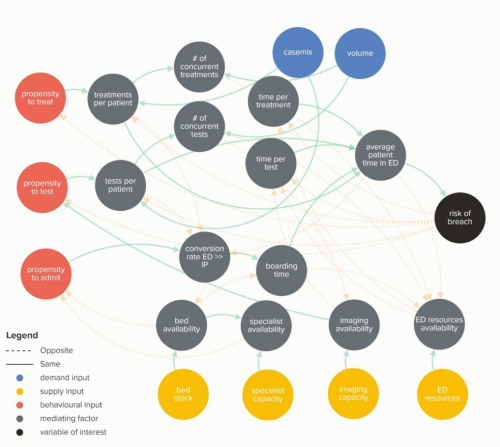The drive for greater integration of health and care services has been the central theme of UK health policy for most of the last decade. There is near universal support for this objective, but little agreement on the best way it can be delivered.
Programmes to improve integration are everywhere. But robust evaluations are few and far between. And when they report, these studies often show negative results: schemes designed to reduce emergency admissions that actually seem to cause them. More empirical evidence is needed; not least to temper policy enthusiasm.
So we were pleasantly surprised when a programme we recently evaluated, to vertically integrate GP and hospital services in Wolverhampton, found (modest) reductions in emergency hospital admissions.[i] Our results were recently published in the British Journal of General Practice.
What is vertical integration?
The concept of vertical integration is not new. In a commercial setting, it describes the strategy whereby a company acquires or merges with one or more of its suppliers or distributors: supermarkets buying out food production firms, video streaming platforms merging with media content producers, or steel producers acquiring car manufacturers for example.
The basic idea is that by merging, a company can remove any unhelpful tension between itself and its suppliers, align objectives, and improve efficiency and quality.
Vertical integration is often contrasted with horizontal integration. This is where suppliers of a similar type come together to seek economies of scale and greater market power.
These two distinct strategies were the centrepiece of NHS England’s Five Year Forward View.[ii] Vertical integration was represented in the PACS (Primary and Acute Care Systems) model. MCPs (Multispecialty Community Providers) represented horizontal integration. The vanguard programme was the means by which these strategies were enacted and assessed.
Vertical Integration of GP and Hospital Services in Wolverhampton
In 2015, the Royal Wolverhampton NHS Trust, a large provider of acute hospital and community services, entered into negotiations with several local GP practices. In June 2016, the first agreement was struck and by February 2018, the Trust had assumed responsibility for the operations of 10 of the 42 GP practices in Wolverhampton.
There are two further pieces of context that are worthy of note:
- the Trust were not one of the 9 PACS vanguard sites. They received no direct support from the (well-funded) vanguard programme
- the Trust had some experience of the process of vertical integration. In 2011 it had taken on the local community nursing and therapy services from Wolverhampton PCT as part of the national Transforming Community Services policy, a policy we also evaluated.[iii]
Measuring what didn’t happen…
Although the objectives of the programme were broad, our evaluation focused on whether the programme led to a reduction in unplanned hospital care: A&E visits, emergency hospital admissions and readmissions.
Quantifying the impact of the programme, even on these narrow measures of healthcare use presents a serious methodological challenge. We needed to measure what happened. But we also needed to estimate what didn’t.
Tracking the rate of unplanned hospital use amongst patients registered with the 10 vertically integrated GP practices is straightforward. The difficultly arises when trying to attribute changes in activity to the vertical integration programme:
Rates of unplanned care across populations fluctuate from week to week, so might the changes we see be caused by chance or natural seasonal cycles? The 10 practices that were integrated were not selected at random, so might there be something unusual about these practices such that reductions in unplanned use were easier to deliver? The UK health system is awash with schemes to reduce unplanned admissions; might one or more of these had an effect on patients of the 10 practices?
So we also needed to know what would otherwise have happened. We needed estimates of unplanned hospital use that would have occurred across the 10 practices if they hadn’t been part of the vertical integration programme.
This ‘counterfactual’ can’t be observed directly because it’s a reality that didn’t occur. But there are a set of approaches, known collectively as quasi-experimental methods, that can sometimes be used to derive credible estimates of counterfactuals. The Strategy Unit’s guide to evaluation guide to evaluation describes some of these methods.
Our evaluation used synthetic controls. The approach creates (synthesizes) a control practice for each of the 10 vertically integrated practices. The control practices are made up of a weighted combination of other practices, drawn from a ‘donor pool’ of practices that were not vertically integrated, from Wolverhampton and adjacent CCGs. Donor pool practices are selected and weighted such that the characteristics of the synthetic control practice match those of the vertically integrated practice prior to the programme.
We compared unplanned hospital use in the 10 vertically integrated practices with their 10 synthetic controls to estimate the effect of the programme.
What did we find?
We found that the vertical integration programme was associated with a modest, but statistically significant, reduction in unplanned hospital admissions. There was roughly 1 fewer admission per 1,000 registered patients per month after vertical integration: a reduction of about 13%.
We also found modest reductions in the subset of these admissions that took place within 28 days of an earlier hospital stay (i.e., unplanned readmissions). We found no impact on the rate of attendances at A&E departments.
In isolation, these results seem modest. Yet they seem less modest against a background of several studies of integration programmes that show negative effects (several of which have been produced by the excellent Sidhu et al, 2020) addresses many of these issues. Primary care in its traditional form has come under sustained pressure in recent years, with demand pressures, staffing constraints and financial sustainability amongst the most pressing issues. Sidhu et al highlight that stakeholders participating in VI programmes see vertical integration as an effective means of managing these pressures.
Sultan Mahmud, Director of Innovation, Integration and Research at the Royal Wolverhampton NHS Trust, said:
“This project was successful because it enabled the breaking down of silos between clinicians, as well as the intelligent use of data to drive care processes, while keeping the focus on patients. We continue to build strong relationships with all local GPs and partners and believe that this will allow us to redesign care processes and move to digitised, anticipatory care that is fit for the future.”
What does this mean for service integrators?
Our study will be seen as a boost for those in favour of the vertical integration approach. But it is only one study. In itself, it can’t provide the certainty that policy makers, clinicians and health service managers would like.
But it is a positive step towards showing that vertical integration can – under the right circumstances – work. Our study adds to the evidence base and in a few years’ time there may be a sufficient number of such studies to offer a more rounded and confident assessment of the benefits of this form of integration.


